bobby.clarky
Tech Compliance Specialist
2
MONTHS
2 2 MONTHS OF SERVICE
LEVEL 1
300 XP
Elastic Stack is formerly known as the ELK Stack.
Elk Stack is a collection of free opensource software from Elastic Company which is specially designed for centralized logging. It allows the searching, analyzing, and visualization of logs from different sources. in this guide, we will learn to install Elastic Stack on ubuntu.
To configure ELK Stack in your Ubuntu platform, there are some prerequisites required for installation.
Table of Content
ELK Stack components
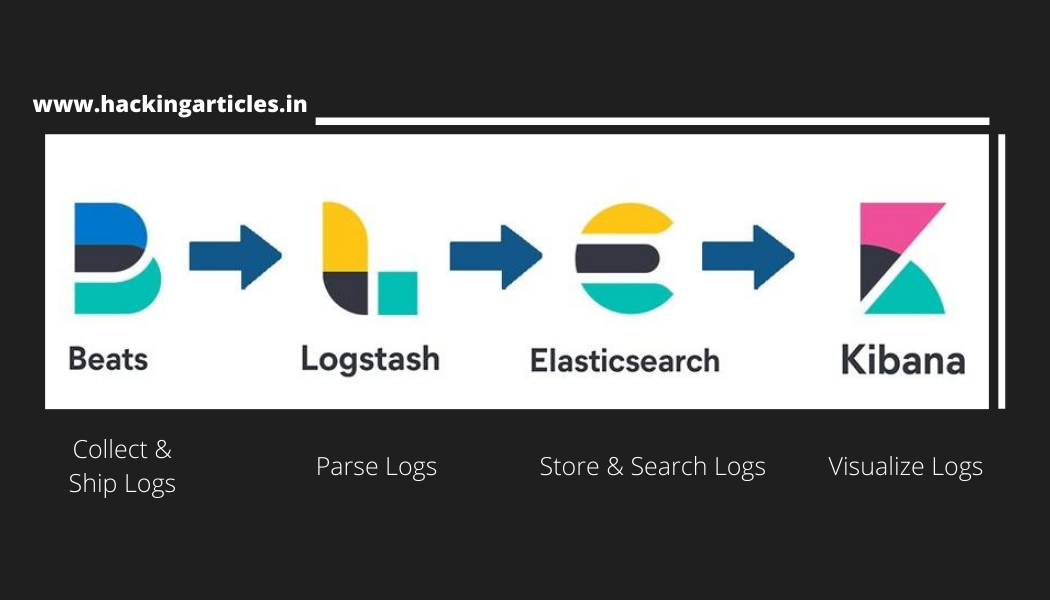
Install Java and All Dependencies
Elasticsearch requires OpenJDK available in our machine. Install Java using the below command along with the HTTPS support and wget packages for APT.

Now, we are going to import Elasticsearch public key into APT. To import the GPG key enter the following command:

Add Elastic repository to the directory sources.list.d by using the following command :

Install and configure Elasticsearch
Update the system repository
Install Elasticsearch by using the following command:

Next, we configure Elasticsearch.
Elasticsearch listens for traffic on port 9200. We are going to restrict outside access to our Elasticsearch instance so that outside parties cannot access data or shut down the elastic cluster through the REST API. Now we’re going to do some modifications to the Elasticsearch configuration file – elasticsearch.yml.
Enter the following command:

Find the line that specifies network.host attribute and uncomment it and add localhost as its value and also uncomment http.port attribute.

Now, start and enable Elasticsearch services.

Let’s verify the status if Elasticsearch.

By default Elasticsearch is listening on the port 9200 you can also verify it on your web browser by pinging https://localhost:9200

Now Elasticsearch is up and running.
Install and configure Logstash
Logstash used to collect and centralizing logs from different servers using filebeat
First Let’s confirm OpenSSL is running and then install Logstash by running following command:

Edit the /etc/hosts file and add the following line

Where 18.224.44.11 is ip address of server elk-master.
Let’s generate an SSL certificate to secure the log data transfer from the client Rsyslog & Filebeat to the Logstash server.
To do this create a new SSL directory under Logstash configuration directory and navigate into that directory generate an SSL certificate by running following command:

Now, we are going to create new configuration files for Logstash named ‘filebeat-input.conf’ as input file from filebeat ‘syslog-filter.conf’ for system logs processing, and ‘output-elasicsearch.conf’ file to define Elasticsearch output.
Navigate to Logstash directory create a file ‘filebeat-input.conf’ in conf.d directory by running command
and paste the following configuration

For the system log data processing, we are going to use a filter plugin named ‘grok’. Create a new conf. file ‘syslog-filter.conf in the same directory
and paste the following configuration lines

And at last create a configuration file ‘output-elasticsearch.conf’ for the output of elasticsearch.
nano conf.d/output-elasticsearch.conf
and paste the following configuration

And at last, save and exit.
Now start, enable & verify the status of Logstash service.

Install and configure Kibana
Install Kibana by using the following command

We are going to do some modifications to the kibana configuration file.

Locate and uncomment the following Attributes

Now start & enable the kibana service:

Install and configure NGINX
Install Nginx and ‘Apache2-utlis’

Now, create a new virtual host file named Kibana.
and paste the following configuration Into the file.

Let’s create authentication for the Kibana Dashboard and activate the Kibana virtual host configuration and test Nginx configuration after that enable & restart the Nginx service by using the following command.

Install and configure Filebeat
We’re going to configure filebeat data shippers on our elk-master server. This will be used to collect data from various sources and transport them to Logstash and Elasticsearch.
Download & Install filebeat by running the following command.

Let’s repackage the downloaded file by using the following command:

Next, open the filebeat configuration file named ‘filebeat.yml’
Edit the configuration file:
we’re going to use Elasticsearch to perform additional processing on data collected by filebeat. Therefore, Enable the filebeat prospectors by changing the ‘enabled’ line value to ‘true’.
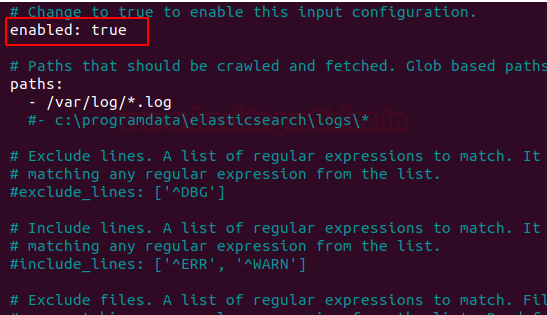
Next head to the Elasticsearch output section and add the following lines
output.elasticsearch:
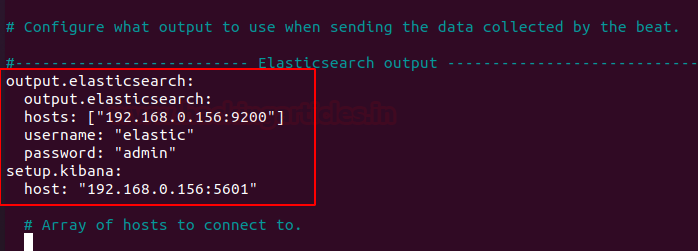
Enable and configure the Elasticsearch module by running following command
sudo filebeat modules enable elasticsearch
Let’s start filebeat
And at last copy the Logstash certificate file – logstash-forwarder.crt – to /etc/filebeat directory by running following command:
To test ELK stack open your browser and browse your server ip address followed by port 5601
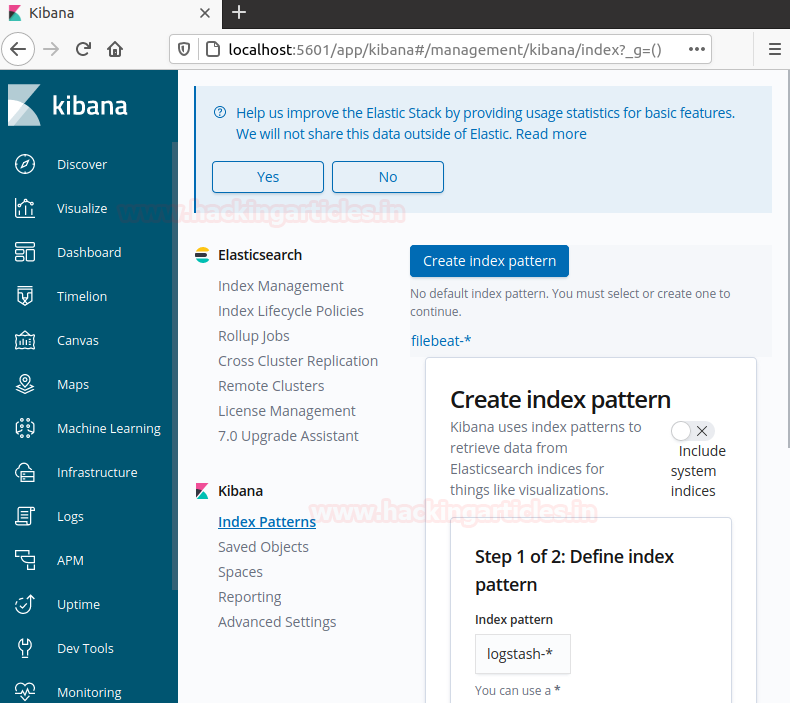
Routing Linux Logs to Elasticsearch
We’re routing logs from rsyslog to Logstash and these logs transferred to Elasticsearch automatically
Routing From Logstash To Elasticsearch
Before routing logs from rsyslog to Logstash firstly we need to set up log forwarding between Logstash and Elasticsearch.
To do this we’re going to create a configuration file for Logstash. To create configuration file head over towards the directory /etc/logstash/conf.d and create a logstash.conf file
paste the following configuration into the logstash.conf file
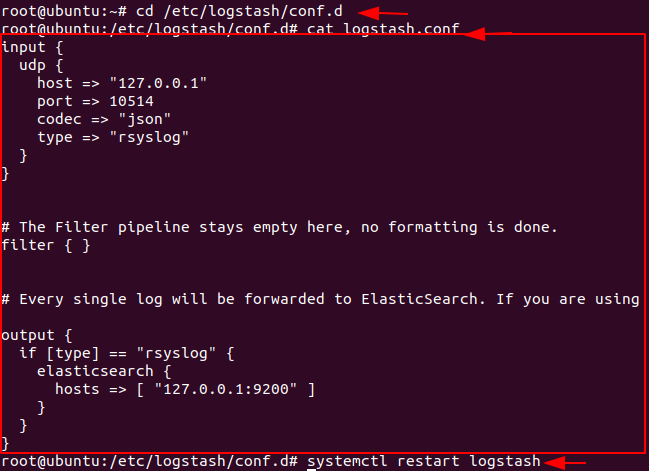
Restart the Logstash service.
Let’s check that everything is running correctly issue the following command:

Routing from rsyslog to Logstash
Rsyslog has the capacity to transform logs using templates in order to forward logs in rsylog, head over to the directory /etc/rsylog.d and create a new file named 70-output.conf
And paste the following configuration into the 70-output.conf file

Now we have log forwarding, create a 01-json-template.conf file in the same folder
And paste the following configuration into the 01-json-template.conf file
Restart rsyslog service and verify that logs are correctly forwarded into Elasticsearch.
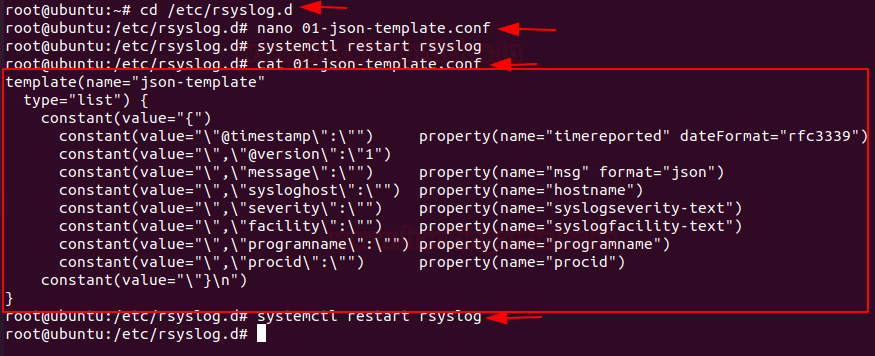
Note:- Logs will be forwarded in an index named logstash-*.
Create a Log Dashboard in Kibana
Open your browser and head over to https://localhost:5601 and you should see the following screen.
Go to the management section and create an index pattern called logstash-* and proceed for the next step.
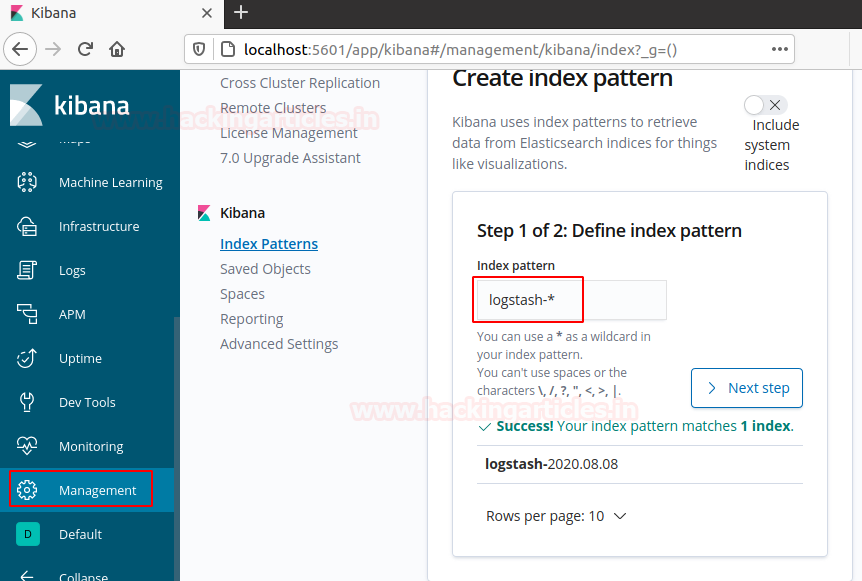
we’ve defined logstash-* as our index pattern. Now we can specify some settings before we create it. In the field of time filter field name choose @timestamp and create an index pattern
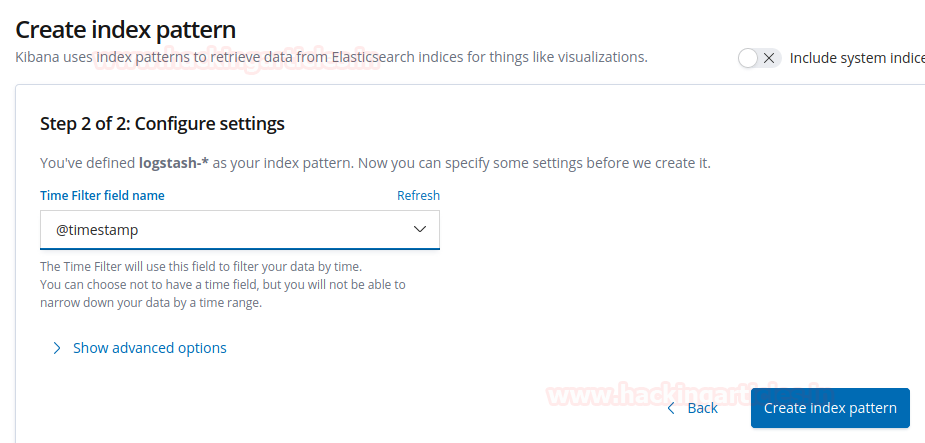
Monitoring SSH entries
This one is a little bit special, as we can go into the “Discover” tab in order to build our panel.
When entering the discover tab, select logstash-*
From there, in the fiterbar, put a query filter “programename:ssh*”.
Now we can see every log related to the SSHd service in our machine.
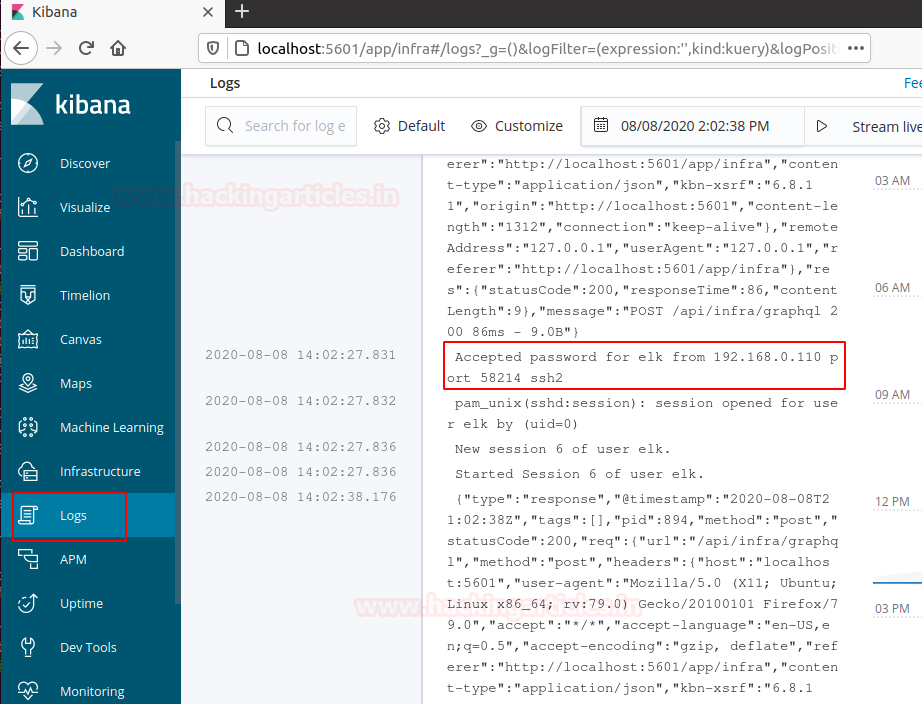
As we can see, now we have direct access to every log related to the SSHd service. we can for example track illegal access attempts or wrong logins.
Similarly, we can monitor various illegal access attempts or wrong logins like ftp, telnet etc…
For example, I took Telnet access to my server from a different machine.
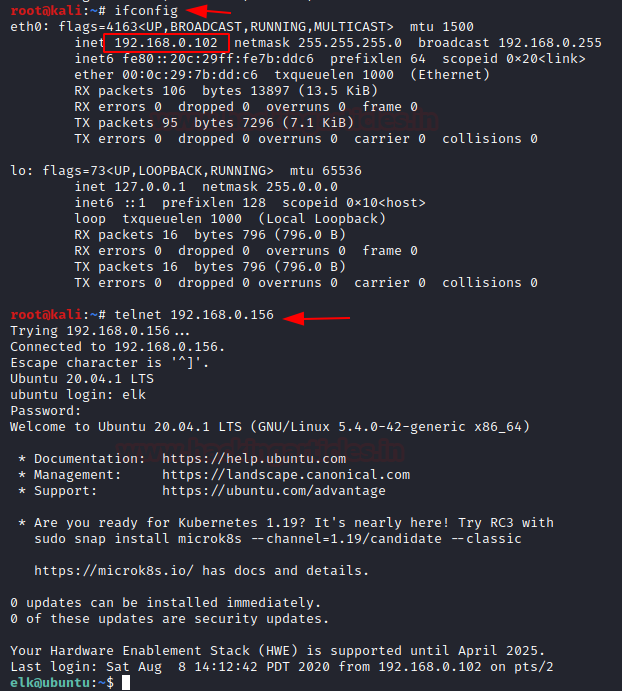
Let’s check what happens on the Kibana dashboard.
Hold tight!

Nice! Now your panel is included in your dashboard.
Author – Vijay is a Certified Ethical Hacker, Technical writer and Penetration Tester at Hacking Articles. Technology and Gadget freak. Contact Here
Elk Stack is a collection of free opensource software from Elastic Company which is specially designed for centralized logging. It allows the searching, analyzing, and visualization of logs from different sources. in this guide, we will learn to install Elastic Stack on ubuntu.
To configure ELK Stack in your Ubuntu platform, there are some prerequisites required for installation.
- Ubuntu 20.04
- Root Privileges
Table of Content
- ELK Stack components
- Install Java and All Dependencies
- Install and configure Elasticsearch
- Install and configure Logstash
- Install and configure Kibana
- Install and configure NGINX
- Install and configure Filebeat
- Routing Linux Logs to Elasticsearch
- Create a Log Dashboard in Kibana
- Monitoring SSH entries
ELK Stack components
- Elasticsearch: It is a restful search engine that stores or holds all of the collected Data.
- Logstash: It is the Data processing component that sends incoming Data to Elasticsearch.
- Kibana: A web interface for searching and visualizing logs.
- Filebeat: A lightweight Single-purpose Data forwarder that can send data from thousands of machines to either Logstash or Elasticsearch.

Install Java and All Dependencies
Elasticsearch requires OpenJDK available in our machine. Install Java using the below command along with the HTTPS support and wget packages for APT.
Code:
apt install -y openjdk-11-jdk wget apt-transport-https curl
Now, we are going to import Elasticsearch public key into APT. To import the GPG key enter the following command:
Code:
wget -qO - https://artifacts.elastic.co/GPG-KEY-elasticsearch | sudo apt-key add –
Add Elastic repository to the directory sources.list.d by using the following command :
Code:
echo "deb https://artifacts.elastic.co/packages/6.x/apt stable main" | sudo tee -a /etc/apt/sources.list.d/elastic-6.x.list
Install and configure Elasticsearch
Update the system repository
Code:
apt updateInstall Elasticsearch by using the following command:
Code:
apt install elasticsearch
Next, we configure Elasticsearch.
Elasticsearch listens for traffic on port 9200. We are going to restrict outside access to our Elasticsearch instance so that outside parties cannot access data or shut down the elastic cluster through the REST API. Now we’re going to do some modifications to the Elasticsearch configuration file – elasticsearch.yml.
Enter the following command:
Code:
nano /etc/elasticsearch/elasticsearch.yml
Find the line that specifies network.host attribute and uncomment it and add localhost as its value and also uncomment http.port attribute.
Code:
network.host: localhost
http.port: 9200
Now, start and enable Elasticsearch services.
Code:
systemctl start elasticsearch
systemctl enable elasticsearch
Let’s verify the status if Elasticsearch.
Code:
systemctl status elasticsearch
curl -X GET "localhost:9200"
By default Elasticsearch is listening on the port 9200 you can also verify it on your web browser by pinging https://localhost:9200

Now Elasticsearch is up and running.
Install and configure Logstash
Logstash used to collect and centralizing logs from different servers using filebeat
First Let’s confirm OpenSSL is running and then install Logstash by running following command:
Code:
openssl version -a
apt install logstash -y
Edit the /etc/hosts file and add the following line
Code:
nano /etc/hosts
Where 18.224.44.11 is ip address of server elk-master.
Let’s generate an SSL certificate to secure the log data transfer from the client Rsyslog & Filebeat to the Logstash server.
To do this create a new SSL directory under Logstash configuration directory and navigate into that directory generate an SSL certificate by running following command:
Code:
mkdir -p /etc/logstash/ssl
cd /etc/logstash/
openssl req -subj '/CN=elk-master/' -x509 -days 3650 -batch -nodes -newkey rsa:2048 -keyout ssl/logstash-forwarder.key -out ssl/logstash-forwarder.crt
Now, we are going to create new configuration files for Logstash named ‘filebeat-input.conf’ as input file from filebeat ‘syslog-filter.conf’ for system logs processing, and ‘output-elasicsearch.conf’ file to define Elasticsearch output.
Navigate to Logstash directory create a file ‘filebeat-input.conf’ in conf.d directory by running command
Code:
cd /etc/logstash/
nano conf.d/filebeat-input.confand paste the following configuration
Code:
input {
beats {
port => 5443
type => syslog
ssl => true
ssl_certificate => "/etc/logstash/ssl/logstash-forwarder.crt"
ssl_key => "/etc/logstash/ssl/logstash-forwarder.key"
}
}
For the system log data processing, we are going to use a filter plugin named ‘grok’. Create a new conf. file ‘syslog-filter.conf in the same directory
Code:
nano conf.d/syslog-filter.confand paste the following configuration lines
Code:
filter {
if [type] == "syslog" {
grok {
match => { "message" => "%{SYSLOGTIMESTAMP:syslog_timestamp} %{SYSLOGHOST:syslog_hostname} %{DATA:syslog_program}(?:\[%{POSINT:syslog_pid}\])?: %{GREEDYDATA:syslog_message}" }
add_field => [ "received_at", "%{@timestamp}" ]
add_field => [ "received_from", "%{host}" ]
}
date {
match => [ "syslog_timestamp", "MMM d HH:mm:ss", "MMM dd HH:mm:ss" ]
}
}
}
And at last create a configuration file ‘output-elasticsearch.conf’ for the output of elasticsearch.
nano conf.d/output-elasticsearch.conf
and paste the following configuration
Code:
output {
elasticsearch { hosts => ["localhost:9200"]
hosts => "localhost:9200"
manage_template => false
index => "%{[@metadata][beat]}-%{+YYYY.MM.dd}"
document_type => "%{[@metadata][type]}"
}
}
And at last, save and exit.
Now start, enable & verify the status of Logstash service.
Code:
systemctl start logstash
systemctl enable logstash
systemctl status logstash
Install and configure Kibana
Install Kibana by using the following command
Code:
apt install kibana
We are going to do some modifications to the kibana configuration file.
Code:
nano /etc/kibana/kibana.yml
Locate and uncomment the following Attributes

Now start & enable the kibana service:
Code:
systemctl enable kibana
systemctl start kibana
Install and configure NGINX
Install Nginx and ‘Apache2-utlis’
Code:
apt install nginx apache2-utils -y
Now, create a new virtual host file named Kibana.
Code:
nano /etc/nginx/sites-available/kibanaand paste the following configuration Into the file.
Code:
server {
listen 80;
server_name localhost;
auth_basic "Restricted Access";
auth_basic_user_file /etc/nginx/.kibana-user;
location / {
proxy_pass https://localhost:5601;
proxy_http_version 1.1;
proxy_set_header Upgrade $http_upgrade;
proxy_set_header Connection 'upgrade';
proxy_set_header Host $host;
proxy_cache_bypass $http_upgrade;
}
}
Let’s create authentication for the Kibana Dashboard and activate the Kibana virtual host configuration and test Nginx configuration after that enable & restart the Nginx service by using the following command.
Code:
sudo htpasswd -c /etc/nginx/.kibana-user elastic
ln -s /etc/nginx/sites-available/kibana /etc/nginx/sites-enabled/
nginx -t
systemctl enable nginx
systemctl restart nginx
Install and configure Filebeat
We’re going to configure filebeat data shippers on our elk-master server. This will be used to collect data from various sources and transport them to Logstash and Elasticsearch.
Download & Install filebeat by running the following command.
Code:
curl -L -O https://artifacts.elastic.co/downloads/beats/filebeat/filebeat-6.8.11-amd64.deb
Let’s repackage the downloaded file by using the following command:
Code:
sudo dpkg -i filebeat-6.8.11-amd64.deb
Next, open the filebeat configuration file named ‘filebeat.yml’
Code:
nano /etc/filebeat/filebeat.ymlEdit the configuration file:
we’re going to use Elasticsearch to perform additional processing on data collected by filebeat. Therefore, Enable the filebeat prospectors by changing the ‘enabled’ line value to ‘true’.

Next head to the Elasticsearch output section and add the following lines
output.elasticsearch:
Code:
hosts: ["192.168.0.156:9200"]
username: "elastic"
password: "123"
setup.kibana:
host: "192.168.0.156:5601"
Enable and configure the Elasticsearch module by running following command
sudo filebeat modules enable elasticsearch
Let’s start filebeat
Code:
sudo filebeat setup
sudo service filebeat startAnd at last copy the Logstash certificate file – logstash-forwarder.crt – to /etc/filebeat directory by running following command:
Code:
cp /etc/logstash/ssl/logstash-forwarder.crt /etc/filebeat/
sudo service filebeat restartTo test ELK stack open your browser and browse your server ip address followed by port 5601
Code:
https://localhost:5601
Routing Linux Logs to Elasticsearch
We’re routing logs from rsyslog to Logstash and these logs transferred to Elasticsearch automatically
Routing From Logstash To Elasticsearch
Before routing logs from rsyslog to Logstash firstly we need to set up log forwarding between Logstash and Elasticsearch.
To do this we’re going to create a configuration file for Logstash. To create configuration file head over towards the directory /etc/logstash/conf.d and create a logstash.conf file
Code:
cd /etc/logstash/conf.d
nano logstash.confpaste the following configuration into the logstash.conf file
Code:
input {
udp {
host => "127.0.0.1"
port => 10514
codec => "json"
type => "rsyslog"
}
}
# The Filter pipeline stays empty here, no formatting is done.
filter { }
# Every single log will be forwarded to ElasticSearch. If you are using another port, you should specify it here.
output {
if [type] == "rsyslog" {
elasticsearch {
hosts => [ "127.0.0.1:9200" ]
}
}
}
Restart the Logstash service.
Code:
systemctl restart logstashLet’s check that everything is running correctly issue the following command:
Code:
netstat -na | grep 10514
Routing from rsyslog to Logstash
Rsyslog has the capacity to transform logs using templates in order to forward logs in rsylog, head over to the directory /etc/rsylog.d and create a new file named 70-output.conf
Code:
cd /etc/rsyslog.d
nano 70-output.confAnd paste the following configuration into the 70-output.conf file
Code:
# This line sends all lines to defined IP address at port 10514
# using the json-template format.
*.* @127.0.0.1:10514;json-template
Now we have log forwarding, create a 01-json-template.conf file in the same folder
Code:
nano 01-json-template.confAnd paste the following configuration into the 01-json-template.conf file
Code:
template(name="json-template"
type="list") {
constant(value="{")
constant(value="\"@timestamp\":\"") property(name="timereported" dateFormat="rfc3339")
constant(value="\",\"@version\":\"1")
constant(value="\",\"message\":\"") property(name="msg" format="json")
constant(value="\",\"sysloghost\":\"") property(name="hostname")
constant(value="\",\"severity\":\"") property(name="syslogseverity-text")
constant(value="\",\"facility\":\"") property(name="syslogfacility-text")
constant(value="\",\"programname\":\"") property(name="programname")
constant(value="\",\"procid\":\"") property(name="procid")
constant(value="\"}\n")
}Restart rsyslog service and verify that logs are correctly forwarded into Elasticsearch.
Code:
systemctl restart rsyslog
curl -XGET 'http://localhost:9200/logstash-*/_search?q=*&pretty'
Note:- Logs will be forwarded in an index named logstash-*.
Create a Log Dashboard in Kibana
Open your browser and head over to https://localhost:5601 and you should see the following screen.
Go to the management section and create an index pattern called logstash-* and proceed for the next step.

we’ve defined logstash-* as our index pattern. Now we can specify some settings before we create it. In the field of time filter field name choose @timestamp and create an index pattern

Monitoring SSH entries
This one is a little bit special, as we can go into the “Discover” tab in order to build our panel.
When entering the discover tab, select logstash-*
From there, in the fiterbar, put a query filter “programename:ssh*”.
Now we can see every log related to the SSHd service in our machine.

As we can see, now we have direct access to every log related to the SSHd service. we can for example track illegal access attempts or wrong logins.
Similarly, we can monitor various illegal access attempts or wrong logins like ftp, telnet etc…
For example, I took Telnet access to my server from a different machine.

Let’s check what happens on the Kibana dashboard.
Hold tight!

Nice! Now your panel is included in your dashboard.
Author – Vijay is a Certified Ethical Hacker, Technical writer and Penetration Tester at Hacking Articles. Technology and Gadget freak. Contact Here